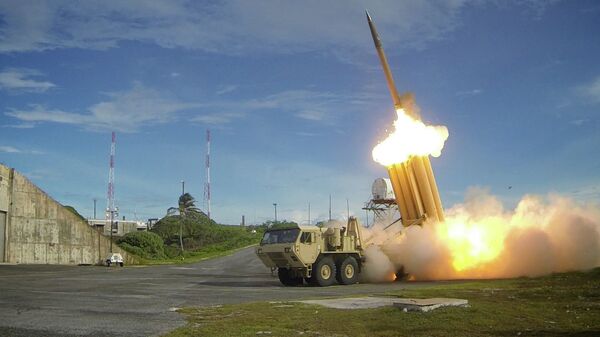The US announced Tuesday that a Lockheed Martin-made Terminal High Altitude Area Defense (THAAD) System stationed in Alaska had managed to intercept a simulated medium-range ballistic missile launched from Hawaii; Russian military expert Vladimir Kozin explained why the further deployment of THAAD will pose a challenge to both Russia and China.
"The successful demonstration of THAAD against an IRBM-range missile threat bolsters the country's defensive capability against developing missile threats in North Korea and other countries," the US Missile Defense Agency said in an official statement.
"The Lockheed Martin-built Terminal High Altitude Area Defense (THAAD) system successfully intercepted a target today in a missile defense test led by the US Missile Defense Agency with critical support provided by the US Army," the official press release said, adding that the system had successfully completed 14 interception attempts since 2005, while the latest test was its first interception of an IRBM.
While the test is regarded as a success there is a serious problem related to the THAAD deployment: the missile defense systems may upset the existing strategic parity in the world.
"There are two points," Vladimir Kozin, a military expert and professor at the Russian Academy of Military Sciences, told Radio Sputnik. "First: offensive weapons can be installed in the launchers of the missile defense systems."
Second, "if the total number of defensive systems of the US missile defense system exceeds the number of nuclear missiles — for instance, in a ratio of two to one — then the United States may be tempted to launch the first nuclear or precision non-nuclear strike on a country 'X' and then successfully hide behind the 'picket fence' of rockets," Kozin noted.
"Thus strategic stability will be undermined," he warned.

"The more interceptor missiles of any kind the Americans have, especially those which are aimed at accomplishing strategic tasks, the greater the danger for our country [Russia]: [in case of a pre-emptive strike] America… would be guaranteed to intercept the nuclear missile response," the military expert stressed, adding that it doesn't matter where the new THAAD systems will be deployed — in South Korea, Alaska or somewhere else.
Russia and China are concerned that the system's radars are capable of monitoring the northern part of Chinese territory and that of Russia, thus undermining the countries' security.
For its part, South Korea claims that the THAAD system deployed in its territory is primarily aimed against North Korea's missile threat.
Recently, Washington made it clear that it won't lend a sympathetic ear to Moscow and Beijing's concerns.
Last Thursday US State Department spokesperson Heather Nauert stated that the United States would continue to deploy its THAAD missile defense systems in South Korea despite recent opposition from Moscow and Beijing.
"[The opposition] is not going to change where we stand on the issue," Nauert said. "We had lots of discussions about the importance of THAAD, the alliance's decision that was made and the reason that those decisions were made to deploy THAAD in the first place…. I just can't see that changing."
Earlier, on July 4 Moscow and Beijing released a joint statement, which called upon the US to stop deploying THAAD missile defense systems in Northeast Asia, stressing that it doesn't contribute to the solution of the simmering Korean crisis or to the goals of denuclearizing the Korean peninsula.





